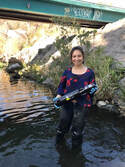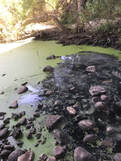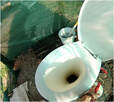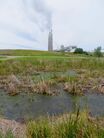As demands on fresh water escalate, there are mounting pressures on natural systems and increasing needs to find sustainable solutions to address global water and sanitation challenges.
PERSISTENCE OF MICROPLASTICS AND OTHER COASTAL POLLUTANTS

|
"Sunlight and tire wear particles - a toxic combination? Evaluating mechanisms for mobilization and degradation of tire particle compounds." Tire wear particles (TWP) are released from abrasion of tires on roadways and are one of the most abundant forms of microplastic pollutants. The research team will identify the diverse compounds leached from tread particles from different tire types under solar exposure and dark conditions, describe their toxicity, and evaluate the persistence and decay of TWP compounds in the presence of simulated sunlight. More information found here. PIs: Mladenov, Hoh, and Sant.
- National Science Foundation (CBET- 2327008) "Assessing Fate and Toxicity of Microplastics under Coastal Environmental Conditions." This study seeks to to 1) evaluate the dissolution of chemicals from microfibers and tire wear particles in seawater under sunlight-exposed and dark conditions, 2) elucidate mechanisms of aquatic toxicity produced by leaching chemicals from the new and aged microplastics, and 3) identify chemicals responsible for toxicity. PIs: Hoh, Sant, and Mladenov.
CSU COAST State Science Information Needs Program. |
|
"Missing the Main Load? Quantifying Marine Debris from Storm Drains and River Margins in the San Diego River." Our team will conduct field, laboratory, and modeling studies to compare relative loading of debris from storm drains and homeless encampments along the San Diego River watershed. This project will inform trash prevention policies, like the California Trash Amendment mandate, which currently does not consider encampment debris PIs: McMillan, Davani, Kinoshita, Biggs, and Mladenov. More information found here.
National Oceanic & Atmospheric Administration |
|
"Persistence of oil-derived hydrocarbons in the coastal environment after the Refugio oil spill." Irradiation experiments show greater persistence and greater number of water soluble organic compounds from Refugio spill oil compared to seep oil under realistic conditions in coastal water. PI: Mladenov.
Read about our study here. CSU Council on Ocean Affairs, Science, & Technology (COAST) |
BORDER WATER STUDIES
|
"Anammox anaerobic baffled reactor pilot study with novel bioelectrochemical system for nitrogen removal from high strength wastewater in Tijuana." Researchers from Tijuana Tech and SDSU plan to simulate high strength, high nitrogen, domestic and industrial wastewater of Tijuana and treat it with an anaerobic baffled reactor (to achieve organic matter and suspended solids removal) coupled in series to an anammox microbial fuel cell (MFC) reactor for nitrogen removal. The novel and low-cost and low-maintenance anammox reactors would have the potential to be incorporated into decentralized wastewater treatment systems and reduce nutrient pollution to surface waters in Tijuana and worldwide.PIs: Mladenov, Dykstra, Oropeza (Tijuana Tech).
SDSU, DRI "Persistence of SARS-CoV-2 in natural waters study" This study seeks to quantify SARS-CoV-2 (the virus the causes Covid-19) in wastewater and evaluate its persistence in the aquatic environment through spiking and degradation experiments combined with sample collection from waterways with known wastewater contamination, such as the Tijuana River. PIs: Mladenov, Verbyla, Sant.
San Diego River Conservancy, CSU COAST |
|
Decentralized Water Reuse for Urban Greening. Here we explore the ideas that 1) urban reforestation and revegetation can reduce erosion and recover degraded urban landscapes, such as those found in Tijuana, and 2) wastewater treated to appropriate standards at a decentralized, neighborhood scale (DEWATS) can provide a consistent and reliable source of water for irrigating these areas. Collaborators: Mladenov (SDSU), Munoz Melendez , Ojeda Revah, and Arteaga (El Colef)
Undergraduate student project leader, Denise Garcia, supported by SDSU IMSD Fellowship. |
FLUORESCENCE-BASED SENSORS
|
Tijuana River sewage monitoring study. Field study evaluating the use of an in-situ multi-parameter sonde with telemetry, which includes fluorescence and other water quality sensors, to provide real-time alerts of sewage and other pollutant inputs to urban rivers in the San Diego-Tijuana border region.
PI: Biggs, co-PI: Mladenov. Sefton Foundation, US Environmental Protection Agency. "Tracking sewage inputs to surface waters with portable fluorescence sensors." Laboratory and field-based testing of portable, submersible fluorescence sensors to track sewage inputs to rivers and other surface waters; comparisons of tryptophan-like fluroescence and TRP:CDOM ratios for discriminating sewage/microbial signal from background organic matter fluorescence. See news coverage of our study. PI: Mladenov.
Undergraduate student project leader, Lorelay Mendoza, supported by SDSU MARC Program Fellowship. "San Diego River sewage monitoring study." Field study evaluating the use of an in-situ multi-parameter sonde with telemetry, which includes fluorescence and other water quality sensors, to provide real-time alerts of sewage and other pollutant inputs to urban rivers in the San Diego-Tijuana border region. PI: Biggs, co-PI: Mladenov.
Sefton Foundation. "Fluorescence-based sensors for water reuse applications." Monitoring of ultrafiltration membrane performance using 3-D fluorescence spectroscopy in tandem with 1-D in-situ submersible fluorometry, water flux, and water quality measurements. Source water control and monitoring of contaminant breach and barrier failure scenarios. PI: Mladenov
SDSU Presidential Leadership Fund. |
ANTHROPOGENIC POLLUTION AND RIVER RESTORATION
|
San Diego River Studies
"San Diego River Contamination Study." This project seeks to distinguish different contributions to human fecal pollution in the San Diego River through analyses of water chemistry, fecal indicator bacteria, and novel microbial and chemical markers of anthropogenic contamination during dry and wet weather. More than two years of research on San Diego River water quality, during storm events and under dry weather conditions, has been synthesized:
San Diego River Conservancy, San Diego Regional Water Quality Control Board, and City of San Diego |
|
"Water quality response to restoration of Alvarado Creek." This project restores native habitat in a section of Alvarado Creek, a tributary of the San Diego River, and implements monitoring to understand the impacts of creek restoration on eco-hydrologic dynamics, water quality, and biological parameters. Mladenov leads the investigation of dissolved organic matter dynamics and contaminant and pathogen mobility during stormwater runoff. PIs: Zink, Mladenov and Kinoshita.
San Diego River Conservancy |
WASTEWATER REUSE TO PROMOTE WATER-ENERGY-FOOD SUSTAINABILITY
|
"Enhanced evaluation of the removal of contaminants of emerging concern in decentralized water reuse systems by non-targeted analysis.” Pilot scale study on chemicals of emerging concern in wastewater treatment and membrane bioreactors using non-targeted approaches: roles of aerobic/anaerobic processes and co-metabolism. Techniques will identify known chemicals as well as the multitude of chemicals that may not yet have been identified with compound-specific monitoring approaches. PIs: Mladenov, Hoh and Dodder.
National Science Foundation (NSF-CBET #1705901) |
|
"Anammox enrichment for polishing of anaerobic wastewater treatment system effluent." A bench-scale anaerobic enrichment reactor is operating for cultivation of anammox bacteria. These bacteria efficiently convert ammonia in wastewater to harmless nitrogen gas without expensive carbon addition and with very low energy requirements. Anammox treatment of wastewater prevents nitrogen pollution and eutrophication. PI: Mladenov
Louis Stokes Alliance for Minority Participation funding for Rivera and MARC Program support for Popova Click here to donate |
|
"IRES Track I: US-Brazil Integrating Engineering and Anthropology Research to Expand Perspectives on Water and Sustainability." Summer research experience in Brazil to study water and sustainability. Open to students who will be juniors, seniors, or graduate students at SDSU or Cal Poly Pomona by Summer or Fall 2019. More information about the research opportunity can be found here: IRES Summer Research in Brazil. PIs: Verbyla, Larkins, Mladenov, Palomo
National Science Foundation (NSF-OISE #1827251) "Unsewered flushing toilet: Performance and optimization for water reuse." Lab-scale study on novel waterless flushing toilet for wide application: residential units, toilets for those experiencing homelessness, national parks, refugee camps, emergency relief. Septic treatment paired with advanced technology for agricultural and other non-potable water reuse applications. PI: Mladenov.
Collaboration with Dr. Epps. Project currently seeking funding! Click here to donate |
|
"US-South Africa collaboration on sustainable sanitation and energy and resource recovery from wastewater." Research experience for SDSU and CPP students at the food-water-energy nexus; a collaboration with scientists and engineers at the University of KwaZulu-Natal to introduce US students to decentralized wastewater treatment and other sustainable water and sanitation systems in urban communities of Durban, South Africa. Read more about this international research activity here (NSF Award Abstract). PI: Mladenov, collaborators: Palomo, Buckley, Casad, Pietruschka.
National Science Foundation (NSF-OISE #1459370) |
|
"Ft. Riley net zero water reuse." Collaboration with Kansas State University, University of Cincinatti, ORD, EPA, USGS, and Fort Riley Army Base on research to evaluate performance of aerobic membrane bioreactor using fluorescence spectroscopy to track pathogen breakthrough and evaluate MBR performance in a water reuse system. PI: Hutchinson, co-PIs: Mladenov and Middendorf.
USGS, EPA, and FT. RILEY |
|
"Improving the quality of powerplant wastewater using constructed wetland systems." Toxic trace elements, such as selenium, arsenic, and mercury, are routinely removed from the air emissions of coal-fired powerplants using flue-gas-desulfurization (FGD) technology. Toxic trace elements and other pollutants ultimately become concentrated in FGD wastewater discharge and pose a threat to water quality. We are evaluating the long-term viability of constructed wetlands for the sequestration of toxic trace elements. PI: Mladenov, co-PIs: Hettiarachchi and Hutchinson.
Kansas State University (Electrical Power Affiiliates Program) |
BIOGEOCHEMICAL PROCESSES RESPONSIBLE FOR ARSENIC MOBILIZATION
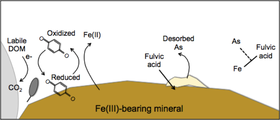
"Toward an improved understanding of reactive organic carbon sources and arsenic mobility in reducing aquifers." Characterization of DOM in groundwater to investigate labile and humic DOM sources in reducing environments with elevated arsenic concentrations. Read more on this NSF-funded project here. PI: Mladenov.
National Science Foundation (NSF CBET #1449247)
National Science Foundation (NSF CBET #1449247)
“Collaborative Research: humics and iron redox reactions in Bangladesh Aquifer." An investigation into the dual role of DOM in reducing aquifers of Bangladesh- as a labile C source for iron reducing bacteria and as an electron shuttle acting to enhance microbial iron reduction. In this setting, evaluating the source and reactivity of DOM is key to gaining a process-level understanding of arsenic mobilization. More on this research... PI: Zheng and Nemergut, co-PIs: McKnight and Mladenov.
National Science Foundation (NSF EAR #0738910)
National Science Foundation (NSF EAR #0738910)
"Investigating the interaction between dissolved organic matter, microbial communities, and arsenic biogeochemistry in groundwater of a pristine delta." We are investigating interactions between organic matter, arsenic, microbes, and metals in a pristine, arid environment, the Okavango Delta of Botswana. We are working with colleagues at the University of Botswana and the Okavango Research Institute to learn more about the competing effects of arid conditions and extreme flood on microbially-driven redox processes and the concentration of solutes in Okavango island groundwater. Read more about this international research activity here. PI: Mladenov.
National Science Foundation (NSF OISE #1105289 )
National Science Foundation (NSF OISE #1105289 )






